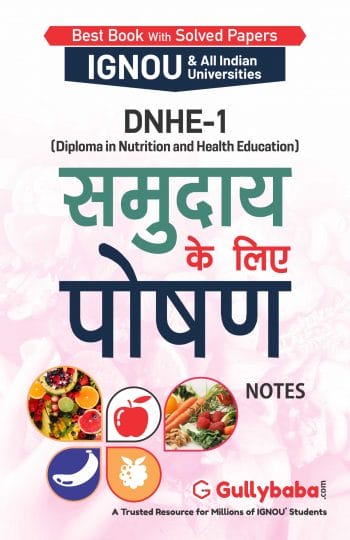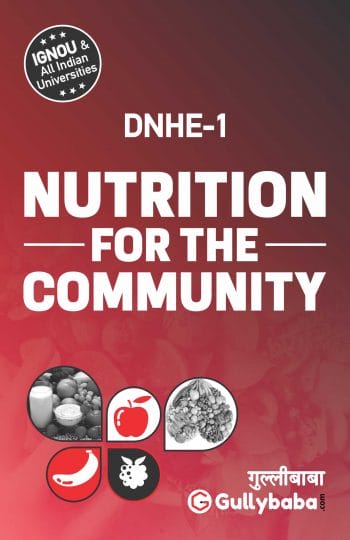IGNOU DNHE-01 (January 2024 - July 2024) Assignment Questions
Part A: Descriptive Type Question
1. a) Define nutrition and health. Elaborate interrelationship between nutrition and health.
b) Enumerate the functions and sources of available and non-available carbohydrates.
2. Enlist the food sources and enumerate the functions of the following vitamins:
a) Vitamin A
b) Vitamin D
c) Vitamin K
3. a) What points would you keep in mind while planning a balanced diet for pregnant woman?
b) Explain in brief the various factors which influence calcium absorption.
c) Define RDA. Why safety margin is added in requirement to calculate RDA?
4. a) Write a note on physiological changes during pregnancy.
b) Define complementary feeding. Enlist the benefits of breastfeeding.
5. Enumerate any 3 criteria for selection of each of the following foods:
a) Pulses
b) Flesh foods
c) Fruits
6. a) What is food spoilage? Explain the causes of food spoilage.
b) Elaborate various methods to enhance nutritive value of foods.
7. a) What are the clinical features of Vitamin A deficiency?
b) Give the etiology and clinical features of the following deficiency diseases:
i) Ariboflavinosis
ii) Pellagra
8. a) What are the risk factors of Coronary heart Diseases?
b) Describe principles of treatment of obesity.
9. Explain briefly:
a) MUAC and BMI
b) Diet survey
c) Growth monitoring
10. a) Write about the objectives and components of ICDS Programme.
b) Give objectives, target groups and dose distribution strategy of NIPI programme.
Section B – Application Question (AQ)
1. Based on the steps involved in planning balanced diet, prepare a diet for a sedentary lactating mother belonging to low socio-economic group. (Refer to DNHE 1, Vol 2, Practical Manual - Part 1, Section 6-Planning Diet-II)
2. Record height and weight of 10 (ten) college going girls/boys (18-23years) in your locality and determine their body mass index (BMI). Classify them to identify their health status based on WHO classification (Refer to DNHE 1 Vol 2, Unit 21, Table 21.1)
3. Visit your locality and identify 10 infant (age: 6 Months-12months) on complementary feeding. In a table record their name, age, gender and the complementary foods introduced to them by their mothers. Analyse whether their diet is in accordance to dietary recommendations suggested for them. (Refer to DNHE 1 Vol 1, Unit 9)
4. Write recipes of any two vegetable dishes prepared at your home. Identify and highlight prepreparation and cooking methods involved in it. Give description/nutritional value of identified pre- preparation and cooking methods. (Refer to DNHE-1, Vol 1, Unit-11)
IGNOU DNHE-01 (January 2023 - July 2023) Assignment Questions
Part A: Descriptive Type Question
1. a) Define health. Elaborate on the four dimensions of health.
b) Explain the functions, digestion and absorption of carbohydrates in our body.
2. Differentiate between the following terms and give suitable examples for each:
a) Saturated and Unsaturated fatty acids
b) Water soluble and fat soluble vitamins
c) Essential and non essential amino acids
3. a) Give the functions, food sources and deficiency of iron.
b) “Foods can be classified based on their functions”. Explain briefly.
4. a) What is food budgeting? List the factors that influence food expenditure.
b) Enlist the steps in the preparation of a short -term monthly budget.
5. Enumerate any 3 criteria for selection of each of the following foods:
a) Cereals and millets
b) Fats and Oils
c) Milk and milk products
6. a) Foods can be classified based on perishability. Comment on the statement giving suitable examples.
b) Elaborate on any 3 techniques used for preservation of food by bacteriostatic method
7. a) What is food adulteration? Explain with examples.
b) Enumerate any simple test by which adulteration can be detected in :
i) Sand or dirt in jaggery
ii) Papaya seeds in black pepper
8. Enlist the clinical manifestations, causes and treatment of the following nutrition related disorders:
a) A 7 year child suffering from Xerophthalmia
b) A 5 year girl suffering from Vitamin D deficiency
9. Explain briefly:
a) Dietary management of Diarrhoea
b) Dietary management of Coronary Heart Disease
10. a) Write about the objectives and components of MDM Programme
b) Enumerate the 4 major methods used to assess nutritional status of individuals. Discuss one in brief.
Section B – Application Question (AQ)
1. Based on the steps involved in planning balanced diet, prepare a diet for a pregnant woman belonging to low socio-economic group. (Refer to DNHE 1, Vol 2, Practical Manual -Part 1, Section 6)
2. Record height and weight of 10 (ten) adults in your locality and determine their body mass index (BMI). Classify them to identify their health status based on WHO classification (Refer to DNHE 1 Vol 2, Unit 21, Table 21.1)
3. Visit your locality and identify 10 individuals who are suffering from diabetes mellitus. In a table record their name, age, gender and the food restrictions made by them in their diet. Analyse whether their diet is in accordance to dietary modifications suggested for diabetes. (Refer to DNHE 1 Vol 2, Unit 21)
4. Visit an Anganwadi functioning under ICDS programme in your neighbourhood. Write the name/age/gender of the beneficiary who came to the Anganwadi that day and services provided to them in that centre. Comment on the services followed, and not being provided. (Refer to DNHE 1 Vol 2, Unit 24)
Buy DNHE-01 Assignment IGNOU DNHE-01 (January 2024 - July 2024) Assignment Questions
भाग क : वर्णनात्मक प्रश्न
1) क) पोषण और स्वास्थ्य को परिभाषित करें। पोषण और स्वास्थ्य के बीच अंतर्संबंध को विस्तार से बतायें। (3)
ख) उपलब्ध और गैर- उपलब्ध कार्बोहाइड्रेट के कार्यो और स्रोतों का वर्णन करें।
2) निम्नलिखित विटामिनों के खाद्य स्रोतों को सूचीबद्ध करें तथा उनके कार्यों का वर्णन करें।
क) विटामिन ए
ख) विटामिन डी
ग) विटामिन के
3) क) गर्भवती महिला के लिए संतुलित आहार की योजना बनाते समय आप किन बातों को ध्यान में (2) रखेंगे?
ख) कैल्शियम अवशोषण को प्रभावित करने वाले विभिन्न कारकों को संक्षेप में समझाइए ।
ग) आरडीए को परिभाषित करें। आरडीए की गणना करने के लिए आवश्यकता में सुरक्षात्मक मात्रा क्यों जोड़ा जाता है?
4) क) गर्भावस्था में होने वाले शारीरिक परिवर्तनों पर एक नोट लिखें।
ख) पूरक आहार को परिभाषित करें। स्तनपान के लाभों को सूचीबद्ध करें।
5) निम्नलिखित खाद्य पदार्थों में से प्रत्येक के चयन के लिए किन्हीं 3 मापदंडों का वर्णन करें:
क) दालें
ख) मांस व मांस से बने पदार्थ
ग) फल
6) क) खाद्य पदार्थो का खराब होना क्या है? खाद्य पदार्थों के खराब होने के कारणों को स्पष्ट कीजिए । (1+2)
ख) खाद्य पदार्थों के पोषक मूल्य को बढ़ाने के लिए अपनाये जाने वाले विभिन्न तरीकों को विस्तार से लिखें ।
7) क) विटामिन ए की कमी के नैदानिक लक्षण क्या हैं?
ख) पोषक तत्वों कमी से हाने वाले निम्नलिखित रोगों के कारणों और नैदानिक लक्षणों को बतायें।
i) राइबोफ्लेबिन हीनता
ii) पेलेग्रा
8) क) हृदय धमनी संबधी रोग के खतरे के कारक क्या हैं?
ख) मोटापे के उपचार के सिद्धांतों का वर्णन कीजिए ।
9) संक्षेप में समझाएं:
क) एम यू ए सी और बी एम आई
ख) आहार सर्वेक्षण
ग) वृद्धि अनुवीक्षण
10) क) आईसीडीएस कार्यक्रम के उद्देश्यों और घटकों के बारे में लिखिए।
ख) एनआईपीआई कार्यक्रम के उद्देश्य, लक्ष्य समूह और खुराक वितरण प्रणाली को बताएं ।
भाग ख - प्रयोगात्मक अभ्यास
1) संतुलित आहार की योजना बनाने में शामिल चरणों के आधार पर कम सामाजिक-आर्थिक समूह से संबंधित एक अल्प श्रम करने वाली स्तनपान कराने वाली मां के लिए आहार योजना तैयार करें। (DNHE 1, भाग-3 प्रयोगात्मक कार्यो की नियमावली भाग 1, भाग-6 आहार नियोजन - ॥ देखें)
2) अपने क्षेत्र के 10 (दस) कॉलेज जाने वाली लड़कियों / लड़कों ( 18-23 वर्ष) की ऊंचाई और वजन रिकॉर्ड करें और उनका बॉडी मास इंडेक्स (बीएमआई) निर्धारित करें। डब्ल्यूएचओं वर्गीकरण के आधार पर उनकी स्वास्थ्य स्थिति की पहचान करने के लिए उन्हें वर्गीकृत करें ( DNHE 1, भाग-2 इकाई-21, तालिका 21.1 देखें) ।
3) अपने क्षेत्र के 10 शिशु (आयु 6 महीने - 12 महीने ) की पहचान करें जिन्हें पूरक आहार दिया जा रहा है। एक तालिका में उनका नाम, आयु, लिंग और उनकी माताओं द्वारा उन्हें दिये गए पूरक खाद्य पदार्थ रिकॉर्ड करें। विश्लेषण करें कि क्या उनका आहार उनके लिए सुझाए गए आहार सिफारिशों के अनुसार है। भाग -1 इकाई 9 देखें)
4) अपने घर पर तैयार किए गए किन्हीं दो सब्जी व्यंजनों की रेसिपी लिखें। इसमें शामिल पूर्व तैयारी और खाना पकाने के तरीकों को पहचानें और रेखांकत करें। पहचान की गई पूर्व तैयारी और खाना पकाने के तरीकों का विवरण / पोषक मूल्य बतायें। (DNHE 1, भाग - 1, इकाई 11 देखें)
IGNOU DNHE-01 (January 2023 - July 2023) Assignment Questions
भाग क : वर्णनात्मक प्रश्न
1) क) स्वास्थ्य को परिभाषित करें। स्वास्थ्य के चार आयामों के बारे में विस्तार से बताएं।
ख) हमारे शरीर में कार्बोहाइड्रेट के कार्यो, पाचन और अवशोषण की व्याख्या कीजिए ।
2) निम्नलिखित शब्दों के बीच अंतर करें और प्रत्येक के लिए उपयुक्त उदाहरण दे
क) संतृप्त और असंतृप्त वसा अम्ल
ख) जल विलेय और वसा विलेय विटामिन
ग) आवश्यक और अनावश्यक अमीनो एसिड
3) क) लौह तत्व के कार्यो, खाद्य स्रोतों और कमी से होने वाला विकार के बारे में लिखें।
ख) "खाद्य पदार्थो को उनके कार्यो के आधार पर वर्गीकृत किया जा सकता है। संक्षेप में समझाइए ।
4) क) खाद्य बजट क्या है? खाद्य व्यय को प्रभावित करने वाले कारकों को सूचीबद्ध कीजिए।
ख) अल्पकालिक मासिक बजट बनाने के चरणों को सूचीबद्ध करें।
5) निम्नलिखित पदार्थों में से प्रत्येक के चयन के लिए किसी भी 3 मानदंडों की गणना करें:
क) अनाज
(ख) वसा और तेल
ग) दूध और दूध उत्पाद
6) क) खाद्य पदार्थों को नष्टता के आधार पर वर्गीकृत किया जा सकता है। उपयुक्त उदाहरण देते हुए कथन पर टिप्पणी करें।
ख) जीवाणुरोधी विधि द्वारा, भोजन के संरक्षण के लिए उपोग की जाने वाली किसी भी तकनीकों पर विस्तार से लिखे।
7) क) खाद्य पदार्थों में मिलावट क्या हैं? उदाहरणों से समझाइए ।
ख) किसी भी सरल परीक्षण की गणना करें, जिसके द्वारा निम्नलिखित मिलावट का पता लगाया जा सकता है :
i) गुड़ मे रेत या गंदगी
ii) काली मिर्च में पपीते के बीज
8) निम्नलिखित में पोषण संबंधी विकारों के नैदानिक अभिव्यक्तियों, कारणों और उपचार को सूचीबद्ध करें:
क) ज़ेरोफ्थाल्मिया से पीड़ित 7 वर्षीय बच्चा
ख) विटामिन डी की कमी से पीड़ित 5 साल की लड़की
9) संक्षेप में समझाएं:
क) अतिसार में आहार व्यवस्था
ख) हृदय धमनी संबंधी रोग की आहार व्यवस्था
10) क) मध्याह भोजन कार्यक्रम के उद्देश्यों और घटकों के बारे में लिखें
ख) व्यक्तियों का पोषण स्तर निर्धारण करने के लिए उपयोग की जाने वाली 4 प्रमुख विधियों की गणना करें। संक्षेप में एक पर चर्चा कीजिए ।
भाग ख प्रयोगात्मक अभ्यास
1) संतुलित आहार की योजना बनाने में शामिल चरणों के आधार पर निम्न सामाजिक-आर्थिक समूह की गर्भवती महिला के लिए आहार तैयार करें। (उत्तर के लिए प्रायोगिक नियमावली के आहार नियोजन ॥ देखें)
2) अपने क्षेत्र के 10 (दस) वयस्कों की ऊंचाई और वज़न रिकॉर्ड करें और उनके बॉडी मास इंडेक्स (बी एम आई) का निर्धारण करें। डब्ल्यू.एच.ओ. वर्गीकरण के आधार पर उनके स्वास्थ्य की स्थिति की पहचान करने के लिये उन्हें वर्गीकृत करें ( उत्तर के लिए इकाई 21, तालिका 21.1 देखें)।
3) अपने क्षेत्र में किन्हीं 10 व्यक्तियों की पहचान करें जो मधुमेह रोग से पीड़ित हैं। एक तालिका में उनके नाम, उम्र, लिंग और उनके द्वारा किए गए भोजन प्रतिबंधो को लिखे। विश्लेषण करें कि क्या उनका आहार मधुमेह के लिए सुझाए गए आहार संशोधनों के अनुसार है।
4) अपने पड़ोस में आई.सी.डी.एस. कार्यक्रम के तहत काम करने वाली आंगनवाड़ी का दौरा करें। उस दिन आंगनवाड़ी में आए लाभार्थी का नाम / आयु / लिंग लिखिए और उस केंद्र में उन्हें प्रदान की गई सेवाएं लिखिए। अनुसरण की गई सेवाओं और वह सेवाएँ जो प्रदान नहीं की जा रही हैं पर टिप्पणी करें। ( उत्तर के लिए इकाई 24 को देखें)
Buy DNHE-01 Assignment 
